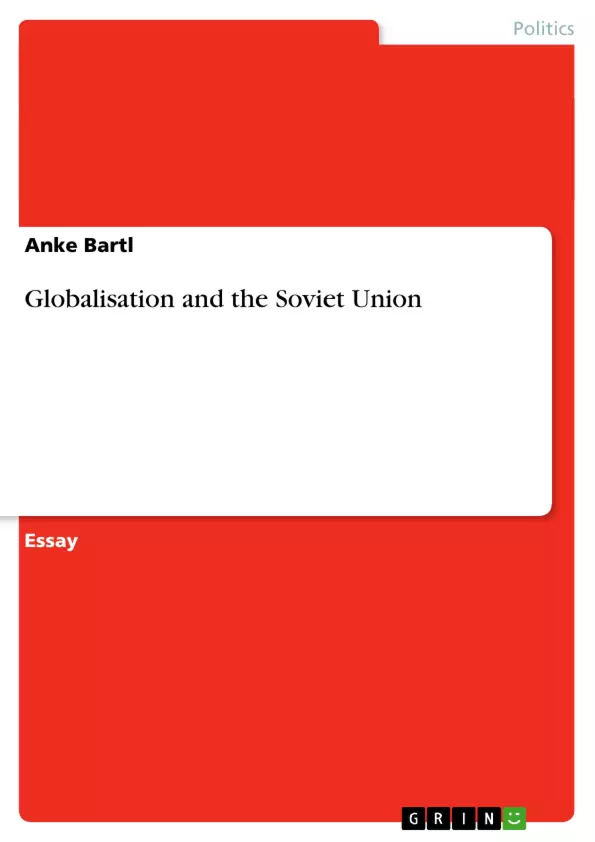This essay aims at explaining the impacts of the processes globalisation on the fall of the
Soviet Union and the problems this created for the new Russia in transition.
First of all it is necessary to look at some parts of the history of the Soviet Union and the
nature of Communism before moving on to defining globalisation and its effects on Russia
and the Commonwealth of Independent States (CIS). Why is it so important to deal with
history first? It is because the former Soviet Union economically and ideologically had shut
itself off to most parts of the globe for decades and hence the effects of globalisation must be
reflected under the light of these specific circumstances.
In short, the Bolshevik uprising in 1917 was successful and brought the Bolshevik Party into
power which was renamed Communist Party in 1918. In the years from 1918 to 1921 a civil
war followed in which the Bolshevik regime was almost overthrown but managed to stay in
power, taking control over the economy and turning it into a war economy. After 1918 the
Soviet Union experienced three years of war communism. Under the wing of Socialism the
economy was organised in a military sense and forced the whole nation to put their labour
into keeping up a traditional army and securing military power.1 In 1921 Lenin introduced
The New Economic Policy as he realised that war communism was a failure and that it had
led to peasant revolts endangering the Soviet State. The idea now was to maintain industry
under state control and to allow a market for agriculture, trade and commerce.2 This system
made it possible for peasants and rural capitalists to gain relative wealth whereas the urban
population experienced increasing unemployment. By the late 1920s this emerging rural
capitalism was regarded as a threat to the system and lead to a very fragile relationship
between the Communist government and the rural population. In order to avoid the collapse
of Communist Soviet Union, Stalin implemented mass collectivisation of agriculture and
rapid industrialisation.3 [...]
1 David Christian, Imperial and Soviet Russia: Power, Privilege and the Challenge of Modernity, Macmillan
Press, Houndsmills, 1997, pp.207 – 231.
2 David Lockwood, The Destruction of the Soviet Union, Macmillan Press, Houndsmills, 2000, p.66.
3 David Christian, Imperial and Soviet Russia: Power, Privilege and the Challenge of Modernity, Macmillan
Press, Houndsmills, 1997, pp. 262 & 265.
Inhaltsverzeichnis (Table of Contents)
- Introduction
- From the Bolshevik uprising to Stalinism (1917-1950)
- War Communism (1918-1921)
- The New Economic Policy (NEP)
- Stalin's Rise to Power
- Mass Collectivisation and Rapid Industrialisation
- The era of stagnation
- Impacts of globalisation and the Gorbachev era
- Declining Birthrate and Natural Resource Access
- The Role of Technology Imports
- Globalisation and the Soviet Economy
- Shock therapy and the IMF
Zielsetzung und Themenschwerpunkte (Objectives and Key Themes)
This essay aims to examine the impact of globalisation on the fall of the Soviet Union and the subsequent challenges faced by Russia in its transition period. It explores how globalisation, in conjunction with historical factors, shaped the collapse of the Soviet system and the emergence of a new Russia.
- The Historical Context of the Soviet Union
- The Rise and Fall of the Soviet Economy
- Globalisation and its Impacts on the Soviet Union
- The Role of Technology and Military Competition
- The Transition to a Market Economy and the Challenges Faced by Russia
Zusammenfassung der Kapitel (Chapter Summaries)
- Introduction: Introduces the essay's aim, which is to analyse the impact of globalisation on the collapse of the Soviet Union and the subsequent challenges faced by Russia in its transition to a market economy.
- From the Bolshevik uprising to Stalinism (1917-1950): Provides a historical overview of the Soviet Union, beginning with the Bolshevik Revolution, the subsequent civil war, and the implementation of War Communism. It then explores the New Economic Policy (NEP), Stalin's rise to power, and the implementation of mass collectivisation and rapid industrialisation.
- The era of stagnation: This chapter examines the period of economic stagnation under Brezhnev, highlighting the Soviet Union's declining birthrate, resource access issues, and the need to shift towards intensive growth. The chapter discusses the importance of technology imports from outside the Soviet bloc and the emergence of a global market driven by neoliberal policies.
- Impacts of globalisation and the Gorbachev era: Focuses on the influence of globalisation on the Soviet economy, particularly its impact on the Soviet military and technological development. It explores the challenges posed by the oil crisis of 1973 and the subsequent decline in oil prices in the early 1980s, which hindered the Soviet Union's ability to finance technology imports. The chapter also introduces Mikhail Gorbachev's rise to power in 1985 and his efforts to implement reforms aimed at reviving the stagnating Soviet economy.
Schlüsselwörter (Keywords)
This essay focuses on the key concepts of globalisation, the Soviet Union, economic stagnation, technological development, military competition, the transition to a market economy, and the challenges faced by Russia during its post-Soviet period. It delves into the influence of globalisation on the Soviet Union's economic and political landscape, exploring the factors that contributed to its collapse and the subsequent transition to a new political and economic order.
- Quote paper
- Anke Bartl (Author), 2003, Globalisation and the Soviet Union, Munich, GRIN Verlag, https://www.grin.com/document/17702



